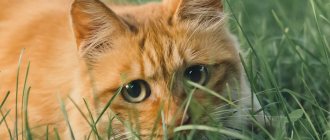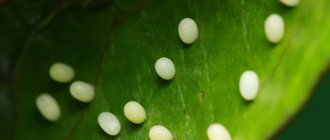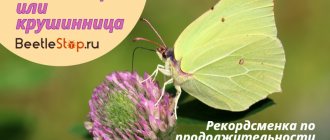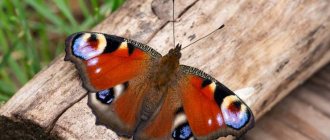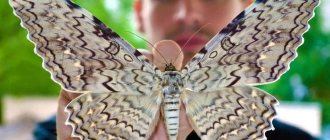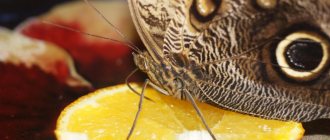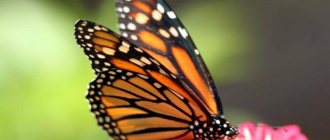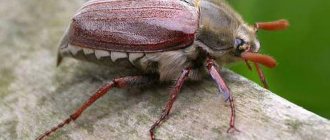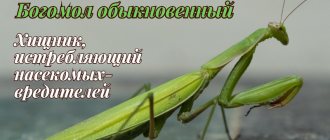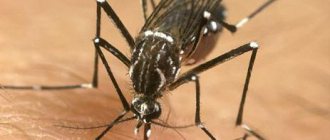Get ready for a journey into the colorful world of insects! You will see unusual butterflies and caterpillars common in the Moscow region, learn to identify them by their external signs and simply get aesthetic pleasure!
When we talk about the benefits of butterflies, we most often mean the properties of adult individuals. Thus, these insects are able to pollinate plants and attract birds to the garden. And if we mention harm, then here we are talking about the caterpillar stage, when the insect actively feeds on plants and can harm garden plantings. The butterflies themselves feed on nectar and are absolutely safe for plant health. Therefore, we will agree in advance that when we call a butterfly “harmful,” we mean its caterpillars.
Now let's take a closer look at the most common fluttering insects that you can find on your site, and determine which of them are useful and which are harmful!
Admiral - butterfly with stripes
Vanessa atalanta, wingspan 50-65 mm
The admiral is easy to recognize: there are red stripes on both sides of his wings. According to one version, it was thanks to this color that the butterfly got its name, because Russian admirals used to have ribbons over their shoulders and red stripes on their trousers. The lower wings of the insect are also decorated with red stripes, on which black dots are clearly visible. The edges of the wings are wavy.
You can meet such a beautiful butterfly not only in Russia, but also in North Africa, North America and even New Zealand. The admiral usually goes to southern countries to spend the winter, but sometimes hides under the bark of trees and remains there until spring. Previously, the admiral was included in the Red Book of Russia, but now the population has recovered.
animalreader.ru
It is not so easy to recognize the admiral's caterpillar as a future butterfly. Dark color, yellow dots on the sides of the body and frightening spikes - the insect is perfectly protected from birds and knows how to camouflage itself. It can be found from May to August on the leaves of nettles, hops and thistles.
How to attract an admiral butterfly. The Admiral loves thistles, asters and blackberries, and at the end of the season he is not averse to eating cracked plums and pears, especially if they have fermented. Place some fruit in a bowl and butterflies will flock to the smell. And to see the caterpillars, plant nettles on the site, which will also be useful as plant food.
The ancient Indians believed that if you catch a butterfly, whisper a cherished wish to it and release it into the wild, it will certainly come true. Try it!
Lonomia Obliqua
Another record holder. But already in terms of toxicity. The butterfly itself is a beautiful and harmless animal, but its caterpillar is protected from any misfortunes.
The caterpillar's spines contain a toxin that reduces blood clotting. If you accidentally touch it, it will cause a long-healing hematoma. But if you “hug” with her or touch several at once, then there is a high chance of dying from a cerebral hemorrhage or kidney failure.
Lives in South America. More often in tropical zones, but it even reaches Argentina. The caterpillar parasitizes many trees, blending perfectly with the bark.
Hawthorn - beautiful and treacherous
Aporia crataegi, wingspan 50-65 mm
Hawthorn can often be found in gardens in the Moscow region. This beautiful butterfly with white wings decorated with black veins flies from apple tree to rosehip, from rowan to plum, from grape to pear to lay its eggs, from which voracious caterpillars will soon emerge. Hawthorn is a “relative” of the famous cabbage. Prefers wetlands and easily travels long distances in search of food and nesting sites.
nature.baikal.ru
Hawthorn caterpillars are covered with thick hairs and can gnaw an entire bush or tree in a short time. They grow slowly, so they make nests in trees for the winter. If leaves entangled with mulberry threads appear on the branches, rest assured that the hawthorn has settled in your garden!
How to deal with hawthorn and its caterpillars. You can place hunting belts on trees and put up birdhouses to attract birds. In early spring, it is worth spraying the plants with a solution of copper sulfate (100 g per 10 liters of water) with the addition of 500 g of urea. If there are a lot of pests, use insecticides: Alatar, Fatrin, Kinmiks, etc. Carry out the treatment during bud break, when the caterpillars emerge from their winter nests, or in the summer after the caterpillars hatch from their eggs.
Cabbage is a dangerous pest of cabbage heads
Pieris brassicae, wingspan – 45-63 mm
Cabbage grass, or cabbage white, is familiar to every summer resident. You can find it in beds with cabbage, turnips, turnips and other cruciferous crops. The butterfly is fussily looking for a place to lay eggs, from which yellow-green caterpillars will soon appear. During the season, one individual lays up to 300 eggs!
Unprepossessing in appearance, the white hare terrifies with its appearance. You should especially be wary of females, the main difference of which is the black spots on the upper wings.
The voracious caterpillars of the white butterfly eat the leaves and prevent the head of cabbage from forming. After a while, only the veins remain from the leaf. When the food runs out, the pests crawl to new plantings.
How to deal with cabbage and its caterpillars. Safe methods include hand-picking caterpillars and catching butterflies. You can also plant marigolds, marigolds, mint or sage between the rows, which will repel pests. A good way is to cover the cabbage with a mosquito net and agro-canvas so that butterflies cannot lay eggs. Folk remedies will help by spraying 2 tbsp. mustard and 1 tsp. ground red pepper per 10 liters of water. And if there are a lot of insects, use Fitoverm, Karbofos, Actellik or another insecticide.
Cetosia biblis
The pattern on the back of the wings of this delicate fluttering creature resembles Arabic writing, which was the name of the family - biblis, translated as “book”.
Insatiable caterpillars of cetosia eat poisonous plants, which subsequently make the insect larvae themselves poisonous. This is evidenced by the red-orange coloring of an already adult individual, warning of the danger of predators who want to feast on it.
In addition to its bright appearance, cetosia is also distinguished by its innate “cunning”. The moth knows how to pretend to be dead - sensing danger, the insect falls on its side and remains motionless until the threat has passed.
Urticaria - a connoisseur of birch sap
Aglais urticae, wingspan – up to 50 mm
You've probably seen this butterfly more than once, but you couldn't even imagine that the offspring of this luxurious beauty feed on stinging nettles! A special sign of urticaria is large black spots on dark orange wings. The hind wings are covered with small blue spots. The insect feeds on nectar of various flowers, and also does not refuse birch sap.
nasekomus.ru
One clutch of wren can contain up to 150 eggs, from which black, hairy caterpillars emerge. They gradually begin to eat the nettles, and at its top they build a nest of cobwebs for shelter from bad weather. After numerous molts, the caterpillar becomes yellow-black and is ready to pupate.
How to attract hives. The answer is obvious - plant nettles! But if you don’t want to see this weed in your summer cottage, try pouring a little birch sap into flat containers to attract insects. And plant lavender, oregano, echinacea, David's buddleia, spirea, bird cherry and other aromatic plants in your flower beds.
- What to plant in a flower garden to fill the garden with an unforgettable aroma
Do you want to plant fragrant flowers on your property? Then take a look at our selection!
Diaethria Eluina
Another little-known beauty. Prefers more southern regions of South America, such as Peru. They are also called “butterfly 88” because of the unusual pattern on the wings.
Size up to 6 cm, its color against the background of tropical plants is lost even for a sophisticated viewer. In fact, this is a genus of butterflies, and the species differ slightly in color from each other. They eat fruit juice.
Their incredible beauty makes the butterfly worry for its life: they are exterminated en masse by collectors, and locals kill them to create souvenirs. Refrain from buying this butterfly, save the species that is harmless and cannot defend itself.
Willow ribbonwort - twilight guest
freenatureimages.eu. Catocala electa, wingspan – 65-88 mm
The second name of this butterfly is willow ribbon. The insect leads a crepuscular lifestyle, so you are unlikely to see it during the day. The butterfly's front wings are gray and inconspicuous, but the lower wings are bright red with black edging and spots in the middle. Moreover, in males the raspberry shade predominates, and in females it is red. The Ribbonwort can also be seen in the fall. It is most often found near bodies of water, in meadows and wetlands. It feeds on tree sap.
pyrgus.de
Caterpillars of the willow tapeworm are perfectly camouflaged. The yellow-gray body is covered with small black dots, the head is brown. The insect feeds on willow and poplar leaves, so it does not harm garden crops. But if you have a willow growing on your site, be vigilant.
How to attract a ribbon girl. It would seem that the insect is nocturnal - why attract it? You can do this at least just to see this amazing butterfly. In the evening, turn on a flashlight or other artificial light source - and the ribbon fly will come to visit you.
Johansonia Acetosea
One of the smallest butterflies. She lives only 10 days, and this includes the life of the caterpillar. The baby's size is only 2 millimeters. By the way, she lives not too far from us. Visitors to the UK can see acetozea in person.
Now let's look at the regions of Russia.
Lemongrass is a long-liver in the world of butterflies
Gonepteryx rhamni, wingspan – 52-60 mm
Lemongrass, or buckthorn, is a rather inconspicuous-looking butterfly from the white butterfly family. Small dots are placed in the center of its wings, and the wings themselves imitate the shape of leaves on a tree. Nature has done its best so that these insects can hide from their enemies!
Males have a richer wing color than females. In the latter, the color of the wings is predominantly greenish-white. The development cycle of one individual takes about a year, which is a rare phenomenon in the world of butterflies. Therefore, lemongrass can safely be called a long-liver.
macroid.ru
Lemongrass lays 1-2 eggs on buckthorn leaves. Then green, smooth, slightly flattened caterpillars appear. Despite their great appetite and fastidiousness, insects do not cause much harm to trees.
How to attract lemongrass. Mostly butterflies feed on the nectar of dandelion, meadow cornflower, thistle, but they will not refuse cultivated plants. It is better to fight weeds that attract lemongrass in your summer cottage.
- How to get rid of weeds - the secrets of “clean” beds
Weed control is the main headache of all summer residents. Let’s figure it out together how to suppress the growth of weeds effectively and easily.
Signs of Lepidoptera
Lepidoptera include insects with the following distinctive features:
- Wings - two pairs of wings are covered with scales, where each scale is a flattened hair. Colors are variable. The larger the butterfly, the fewer wing beats it makes per second. The movements of the insect are chaotic, irregular, zigzag. Thanks to this feature, it is difficult for birds to catch them in flight.
- Oral apparatus . Most butterflies have a special proboscis for absorbing liquid food. Its length allows you to consume nectar even from deep flowers or cracked fruits/berries. During flight and rest, the proboscis is twisted into a spiral. The primitive representatives of the order have working upper jaws (mandibles), just like a caterpillar. Some adult individuals have no oral apparatus at all, as the butterfly continues to consume the protein stored during the larval stage of development.
- Development with complete transformation. The adult mates and lays eggs on the “food” plant. The hatched caterpillars eat the plant. A fully grown caterpillar turns into a pupa, becoming covered with a hard shell in which the formation of an adult butterfly occurs.
Butterfly proboscis under a microscope
Malinnitsa is a modest record holder
commons.wikimedia.org by Charles J Sharp. Callophrys rubi, wingspan 26-28 mm
The raspberry and the raspberry blueberry are the same butterfly from the genus Greenfinch. It is not easy to notice it, because... the outside of the insect is brown and the inside is green. In addition, the butterfly is small and almost always keeps its wings folded for camouflage. You can meet her not only at the dacha, where she flies for flower nectar, but also in swamps and meadows. Raspberries are common in the temperate zone of Eurasia. The butterfly's habitat reaches the Polar Urals, and in the Alps it sometimes rises to a height of up to 1800 m!
insectamo.ru, author: Ponomarev A. G.
Raspberry caterpillars have a fairly rich “menu”, which includes leaves of blueberry, heather, birch, gorse, buckthorn and other plants. What about raspberries, you ask? Alas, raspberry caterpillars really will not refuse raspberry and currant leaves. But despite their food preferences, they are rare on these plants. Insects are sensitive to chemicals, so they prefer to stay away from summer cottages. In addition, this species is quite rare in nature.
Some blueberry caterpillars are able to pass themselves off as ant larvae. As a result, the ants feed the caterpillars, and the latter, without hesitation, also eat the eggs and larvae of their benefactors.
How to attract raspberries. The raspberry tree is not one of those butterflies that will circle brightly over a flower bed. But if you have clover, sweet peas or vetch, she may come briefly to collect sweet nectar.
Lifestyle
From several days to several weeks - this is how short the lifespan of most butterfly species is. Therefore, the entire lifestyle of these creatures is based on the main task - to have time to reproduce.
Insects try to protect their lives in all available ways:
- Poisons/Unpleasant Taste – Some species, such as Monarch and Swallowtail, are poisonous. Their bitter taste can cause birds to vomit and, in some cases, cause cardiac arrest. Birds quickly remember this fact and fly around butterflies with similar colors.
- Mimicry/protective coloration . Some edible butterflies look as repulsive as poisonous ones, thereby giving them a double chance of survival. Others have a terrifying coloring that imitates the wide eyes of a predator. Still others hide using camouflage, since the pattern and color of the wings practically copies leaves or flowers.
- Sound imitation . It sounds amazing, but the death's head butterfly is distinguished not only by its menacing appearance, but also by its ability to sing exactly the same way as the queen bee does! Thus, she lulls the vigilance of the bees and enters the hive to drink sweet honey. The caterpillar of the blueberry butterfly can imitate the song of the queen ant. Due to this skill, she lives quietly inside the anthill until pupation, receiving food and protection from the ants.
- Spikes/Unpleasant Smell – The caterpillars of many butterflies are covered in coarse hairs that repel small animals and birds. Thus, the caterpillars of swallowtail butterflies have a special Y-shaped osmeterium gland, which protrudes and emits a foul odor whenever the insect senses the approach of danger.
Owl butterfly of the genus Caligo
Some butterflies, like birds, are migratory. For example, monarch butterflies annually travel from Canada to Mexico, covering a path of more than 5 thousand km. It is noteworthy that only one generation of butterflies completes the flight from north to south and breeding offspring, while four generations complete the full life cycle during the return journey.
Despite the fact that butterflies have limbs, they are too weak and not suitable for long walks.
Swallowtail - Queen of Butterflies
Papilio machaon, wingspan – 64-95 cm
It’s hard not to notice such a butterfly! Swallowtail attracts attention with its large size and bright color. The butterfly got its name from the name of a mythological doctor who participated in the Trojan War. A special feature of the swallowtail is the “tails” up to 10 mm in length on the hind wings.
Swallowtail is found all over the world: in Europe, Asia, North America and North Africa. The butterfly population in the middle zone suffers from fires and trampling of meadows. The species is listed in the Moscow Red Book.
The bright swallowtail caterpillars resemble fantastic creatures. Immediately after birth, they begin to feed. In the Moscow region, insects prefer umbrella crops: hogweed, carrots, parsley, fennel and dill. If a caterpillar gets into a garden bed, it can quickly destroy the above-ground parts of the plants. But this happens extremely rarely, because... The swallowtail practically does not fly to summer cottages.
How to deal with swallowtail caterpillars. Carefully remove them and take them outside the site, planting them on some kind of umbrella crop. Be careful, the “horns” of the caterpillars secrete a caustic liquid, so it is better not to pick up the insect with your hands, but tear it off along with a piece of the plant on which it sits.
Images
Even those who hate insects will not deny the beauty and grace of butterflies. We invite you to look at a selection of photographs of these amazing lepidopteran creatures and enjoy the variety of shapes, sizes and types.
Peacock's eye - the most picturesque butterfly of the middle zone
Aglais io, wingspan up to 62 mm
This butterfly will not leave any summer resident indifferent! The insect will decorate any flower garden and its offspring will not cause any harm to the garden. The round spots on the front and hind wings of the butterfly are very reminiscent of the spots on the tail of a peacock. With the help of such a cunning device, the peacock's eye often confuses birds that would like to feast on the butterfly.
dic.academic.ru
The peacock eye caterpillar is not so noticeable, although its black spines can also scare off enemies. Black caterpillars live in large colonies of up to several dozen individuals. They mainly prefer to eat nettles, thistles or hops, and less often – willow and raspberries.
How to attract a peacock eye. These butterflies are excellent pollinators. To attract them to the garden, plant flowers in shades of red, pink, orange or yellow in your flower bed. And also plant some nettles in the area.
How to control peacock eye caterpillars. An invasion of caterpillars can damage the raspberry tree, but if in the spring you treated the plantings with insecticides as standard, do not worry about the safety of the crop. It is easier to remove pest colonies manually.
Moscow
In Moscow you can find up to 200 species of butterflies. Their peak activity occurs in July-August. I won’t list endangered species, just a couple of common ones so you can recognize them on the street and in the park.
This is a corner cover with white:
And the caterpillars of these beauties eat your harvest. Hawthorn hawthorn and other whites:
You often saw the lemongrass in the forests and called it lemongrass.
Hives:
Don't forget about the peacock eye and admiral mentioned above. These species are found throughout European Russia. In Siberia and the Far East, in places where the snow does melt, the same species of butterflies are found. And local endemics.
Mother of pearl - the enemy of apple trees, blackberries and raspberries
Argynnis paphia, wingspan up to 75 mm
The pearlwort is a fairly large daytime butterfly with an unusual spotted color. The name of the insect was given because of the iridescent greenish-silver spots by which butterflies recognize individuals of their species. In warm weather, you can see flocks of pearlworts busily flying over the flower beds. These lepidopterans are also found along roadsides, in clearings and near rivers. There are many subspecies of Argynnis paphia, each of which feeds on specific crops.
molbiol.ru
Most often found in the country are large mother of pearl. Food plants for its caterpillars are apple trees, blackberries, raspberries, and violets. The body of the larvae is covered with many villi.
How to deal with mother of pearl and its caterpillars. There are different ways to protect plants from caterpillars. The simplest is to install trapping belts or pheromone traps and inspect them regularly. Regular removal of curled leaves and attracting birds will also help. It is better to choose biological drugs: Fitoverm, Bitobaxibacillin, Entobacterin, etc.
Habitats
Where do butterflies live? Butterflies live almost everywhere, with the exception of the northern Arctic latitudes. Of course, they are not there in the cold either.
Antarctica. In general, butterflies love warmth, so they are especially abundant in warm tropical latitudes.
Meadow pestle is a poisonous insect
Zygaenidae, wingspan 16-38 mm
Groups of pests often flutter over flower beds in sunny weather. Insects are easy to recognize: they have rounded red spots on their dark blue or green wings. In addition, unlike other butterflies, the wings of the meadow moth are folded like a roof, like those of moths. If a butterfly is caught, it will begin to secrete repellent foam. In nature, no one hunts a butterfly. It is poisonous and itself very resistant to poisons.
Caterpillars of moths are densely covered with warts, from which small bristles protrude. Body color: yellow-green with a scattering of black spots. Caterpillars can also secrete protective substances, so it is better not to handle insects with your bare hands. They feed mainly on clover and grasshoppers.
How to attract meadow moth. Plant clover, plantain, alfalfa or thyme in the area. The butterfly will also be happy with the dandelion, but usually, on the contrary, they try to remove it from the site.
- How to get rid of dandelions on your property - useful tips for summer residents
Dandelions feel great in your area and threaten to “take over” it completely? Fight the weeds!
Glory of Bhutan - Unusual Moth
©
The unusual and peculiar shape of this species of butterfly attracts the attention of even those who are not particularly fond of insects of this species. And the wingspan and ability to camouflage by folding wings one on top of the other is surprising and amazing. The Indian beauty butterfly lives in mountains and forests, and is carefully protected by the state. Each wing has three tails of different lengths, which give the whole image sophistication and grace, and bright red spots loom like signal identifiers: “You can’t eat me, I’m inedible.”
8
Burdock - a lover of overseas travel
Vanessa cardui, wingspan 47-65 mm
The burdock butterfly, or thistle, is often confused with the urticaria. They are really similar, but, unlike the urticaria, the burdock is much larger and has black, rather than blue, spots on its hind wings. The number of this species varies from year to year. For example, in 2009 there were especially many of them. For the winter, burdocks fly to North Africa, and then return to the European continent and begin breeding.
wallhere.com
Females lay one egg each on thistle, burdock, coltsfoot, yarrow or nettle. After hatching, the caterpillar makes a shelter out of leaves. Over the course of her life, she can change at least 7 of them. Depending on the food plant, the color of the caterpillars will also change. At the dacha, they will help fight weeds and become food for birds.
In the southern regions of Russia, burdock caterpillars can infect tomatoes, eggplants, soybeans, and melons.
How to attract a burdock. Plant cosmos, asters, saplings, David's buddleia, phlox and other plants attractive to butterflies in your flower beds. Thickets of thistles near the site will also attract the attention of thistles.
Morpho Menelaus
A little exotic in the feed. This beauty lives in South and Central America and respects the jungle. Eats anything, but due to competition, prefers rot.
Their wings are not blue, they are reflective scales. In life it looks metallic, and the color depends on the lighting.
And this is one of the largest butterflies in the world, up to 15 cm in span. There's nothing interesting to say about her life, so just look at the beauty you can find in the tropics.

